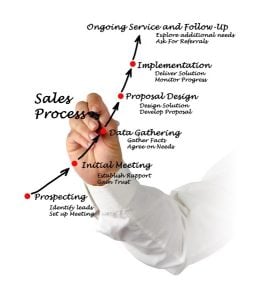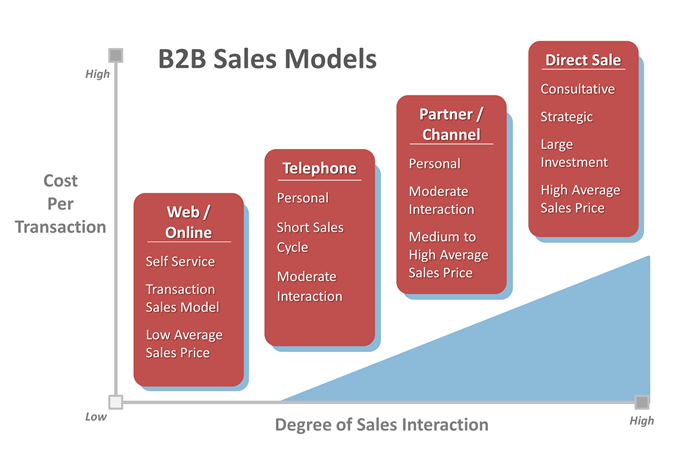Last month, my column discussed the importance of creating a powerful brand promise, the first component of a productive lead-to-revenue (L2R) strategy. Component two is the choice of the most effective sales and marketing model.

Our recent 2017 Trends in B2B Marketing and Lead-to-Revenue Report showed that 88 percent of the B2B companies surveyed stated that they would evaluate their sales model and processes in the coming year. This is not to say that the 88 percent necessarily have the wrong model, but rather, that they are smart enough to periodically test their assumptions.
Every B2B sales model includes:
- How you identify target segments and individual prospects
- Media and tactics to generate leads
- Methods and systems to capture prospect data
- What actions to take, when and with whom
- How to manage and nurture prospects
- How frequently and forcefully to communicate
- How you make the sale (and generate revenue)
- How you communicate and measure results internally
Although there are dozens of permutations, the below graphic shows four major sales models: direct, telephone, channel and online. Each of these has its pros and cons, but there are two primary attributes. First is the amount of personal interaction required from your sales team, which can range from very high in the case of direct sales (e.g. enterprise software, industrial machinery), to very low in the case of online sales (e.g. Amzon.com). The key point is that you don’t want major rep time spent making low dollar sales. I’ve seen cloud/SaaS software vendors make this mistake when they apply enterprise selling techniques to sell products that produce only a fraction of the revenue.

The second axis of the diagram refers to the cost of each transaction. This is often referred to as “cost-per-customer acquisition” (CAC). Understanding your CAC data is crucial because it indicates whether you have a profitable and sustainable sales model. About 43 percent of respondents to the 2017 L2R survey reported that their acquisition cost is rising — a sign that these companies may have the wrong sales model. The goal (easier stated than done) is to drive the largest possible transaction amount — with the lowest cost and least amount of sales interaction. I talked about how to do this in my recent article “Six Ways Marketing Can Shrink the Sales Cycle.”
Sales Model Comparison
To illustrate the above principles, let’s look at two very different sales models. In the first example, awareness is created and inbound inquiries are fed to a business development function. Direct sales reps will only see leads that have been pre-qualified, usually by a business development rep (BDR) who qualifies inquirers by asking a series of questions about budget, authority, timing and so forth. To best support this type of sales model, we want to drive as much activity into the top of the funnel as possible, creating the critical mass of inquiries needed to achieve the target number of qualified leads that have passed through the qualification process.
Let’s now look at the second sales model and how we align it with the marketing plan. If an organization utilizes a direct sales force, but provides no pre-qualification function (e.g. no BDRs), our focus in the marketing portion of L2R will be more on quality than quantity. This is true because we know that in most B2B scenarios, somewhere between 10 and 15 percent of all inquiries will pass the qualification filter. This means that sales reps will talk to eight or nine suspects before reaching one qualified prospect. This imbalance leads to two negative consequences. First, the reps fail to call all the suspects, finding reasons to disqualify them before making the calls. Second, reps get busy chasing their hot prospects and neglect to make the qualification calls in a timely manner.
In this type of sales model, we purposefully back off the quantity goal and align our marketing plan to deliver leads that are more qualified. When sales reps discover that half their suspects are qualified — and have potential to enter the sales pipeline — they are more diligent with their follow-up. Another way to tweak this type of model is to require suspects to provide more data about themselves on the web form, thus pre-qualifying or disqualifying themselves. Each additional piece of data you ask for will reduce the number of responses, but will also drive up average lead quality.
Keep in mind the adage about how efficiency is “doing things right” while effectiveness is “doing the right things”. Choosing the right sales model is about the latter. And if you are not doing the right thing when it comes to selecting the right sales model, it is very difficult to be more successful by adding more efficiency to a flawed model.
So how do you know when you have the right model? Here are five key attributes:
1. The model produces the desired revenue.
2. Customers are acquired at reasonable cost.
3. The model aligns with the buyer’s preferred buying process.
4. Your people, processes and technology are fully optimized.
5. Your marketing and sales forecasts become predictable.
In my next article, we’ll explore the third critical lead-to-revenue component: Efficient marketing and sales processes.




“Another way to tweak this type of model is to require suspects to provide more data about themselves on the web form, thus pre-qualifying or disqualifying themselves. Each additional piece of data you ask for will reduce the number of responses, but will also drive up average lead quality.”
This is the single best thing I have done in the past weeks to drive lead quality. Thank you also for the section on the five key sales model attributes. We have a few weaknesses in our array of sales models that this section helped me with– I have to have a tough conversation tomorrow about that.
Thank you Chris–as always, really practical and valuable insight.
Corinne, thanks so much for your comments. Your point about tweaking the sales model to get suspects to provide more data about themselves is a good one.